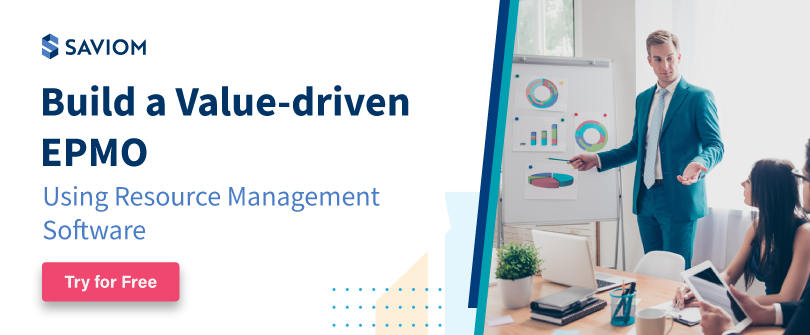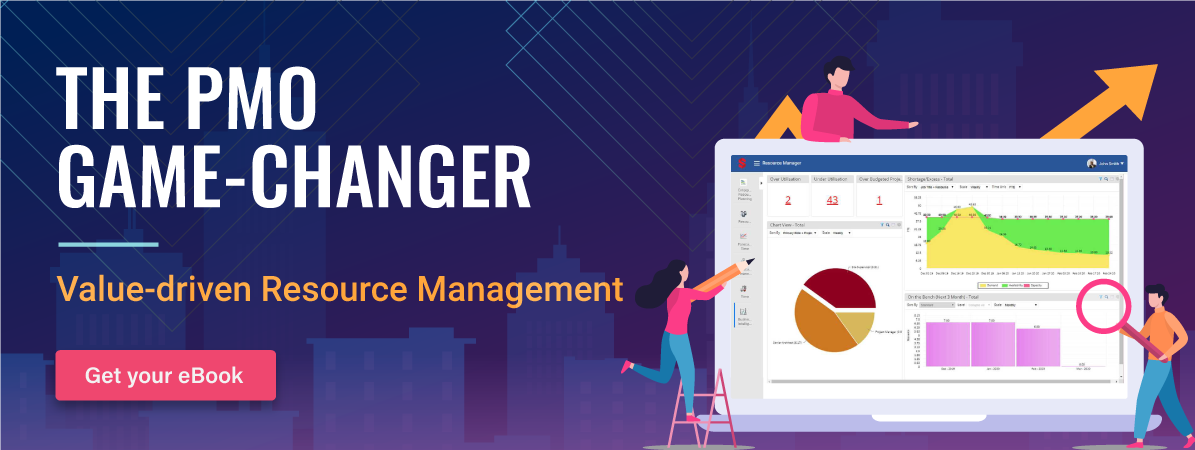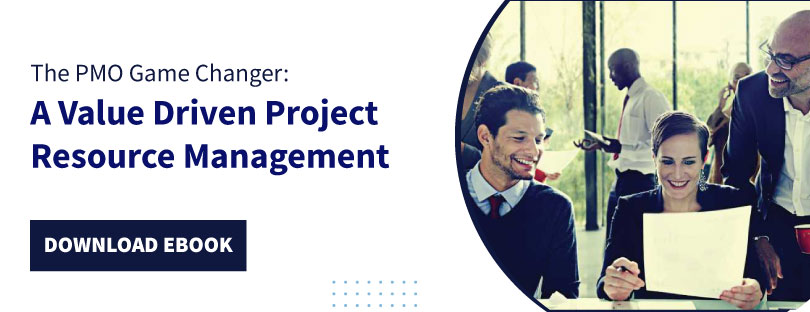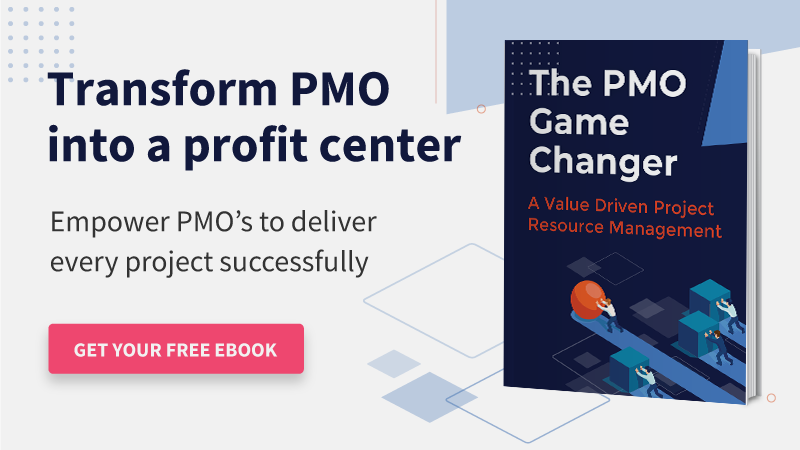The disconnect between project goals and business strategy is one of the most common reasons for project failure. Businesses must be equipped to deal with market uncertainties and adjust to the new dynamics for survival.
The relevance of PMO in an organization has grown tremendously because it has increased the project success rates and made delivery more standardized and predictable. However, large organizations do setup several PMOs, which has its challenges in coordination.
As a result, many successful businesses set up an Enterprise Project Management Office (EPMO) to coordinate several project management offices (PMO). In the EPMO structure, project, program, and portfolio managers jointly participate in strategic planning sessions to increase project success rates.
Having a centralized body to monitor and benchmark performance against several checkpoints allows companies to remain informed and ready to embrace any sudden change. A value-driven EPMO can potentially become a game-changer and be a vital part of business profitability.
To understand what is involved in setting up an EPMO, let us look at its structure and framework.
What is EPMO?
The EPMO is a centralized business function that ensures a strategic alignment between your business objectives and the number of projects executed. It operates at a strategic level to ensure projects and portfolio activities are being governed to benefit the overall business.
Organizations with a global presence feel the impact of non-uniformity when technologies and processes vary in different geographies. A balanced EPMO framework provides company-wide guidance, governance, standardized processes, project portfolio management, value-added resource management, best practices, tools, and techniques.

According to Statista, “80% of organizations have established PMO to execute projects”.
The purpose of setting up an EPMO is to record, analyze, and present information to senior leadership that allows them to see if a program’s road map tests thoroughly.
It is the strategic arm of decision making that ensures how value is created across the enterprise. Additionally, it also addresses:
- The ambiguity between different PMO organizations
- Distribution of underutilized resources
- Project Resource Cost across the company
- Individual project goal vs. big picture
Following are some of the business benefits of a value-driven EPMO:
- Provide Real-Time Visibility Across the Enterprise
- Implements Standards and Best Industry Practices
- Aligns Projects with Business Objectives
- Helps in Informed Decision Making
- Reduce Project Resourcing Cost
- Improves Billable & Strategic Resource Utilization
- Leverage Global Resources from low-cost locations
- Build Shareable Assets
- Improves Employee Engagement and Productivity
Challenges with Traditional PMOs
There are three different types of PMOs, namely:
Project Management Office- Project Management Offices are typically set up for large projects. They help project managers track deliverables, collect timesheets, compile status reports and financial data, mitigate issues and risks, etc.
Program Management Office – Program Management Offices are formed at the Program level, where multiple projects are running under one program. Program Management Offices support project managers, program managers, and project teams.
Portfolio Management Office – Portfolio Management Offices are created at the Business unit/ Department level to ensure that the projects align with overall enterprise business objectives.
Here are some of the challenges and limitations faced by Project/Program/Portfolio management offices (PMOs) :
- Due to the use of home-grown tools or silos of spreadsheets, many traditional PMOs cannot provide a single real-time view of resource-related data. It can create data inconsistency leading to incorrect decision making.
- Many PMOs operating at the department, program, and project level take up a bottom-up approach to tackle issues. These PMOs often lack strategic alignment.
- PMOs in large organizations or PMOs dispersed geographically in a global organization work in silos. This federated approach leads to a lack of communication and operational inefficiencies.
- Most EPMOs are struggling to manage project resource costs, optimize billable utilization of resources, and futureproof their business against market volatility.
- Many PMOs are not involved in overall Demand Management at the organizational level. Therefore, it is difficult to forecast the resource demand pipeline for a multi-year horizon.
- PMO operations are unable to present the big picture while reporting to the leadership team. The senior management wants to see consolidated reports for the enterprise-wide programs so that they do not get bogged down with minute details.
- Departments within an organization may lack standardization in the way they run projects. This may be due to several reasons, such as the organization has gone through mergers and acquisitions.
- Projects running with traditional PMOs may not have visibility at the top executive level and lack leadership buy-in.
EPMO versus PMO
A traditional PMO sets the direction, maintains, and ensures standards, best practices, and the status of project management across an organization. PMOs primarily do not focus on the strategic goal alignment of an organization.
An EPMO has the same responsibilities as a traditional PMO, but it also aligns all project, program, and portfolio activities with company-wide strategic objectives.
According to PMI(2017), out of 81% of the firms that house a PMO, over half of them also have a strategically positioned EPMO. Such companies report being able to complete 38% of their projects after aligning them to strategic goals.
Read More: 5 Project Selection Criteria to Structure the PMO
EPMO Best Practices
EPMO best practices are based on the goals, business models, and long-term strategies of an organization. It aims to achieve a higher project, program, portfolio, and strategic goal execution and success rates. It combines the following elements into a working framework:
- Mission and Vision
- Corporate Governance
- Strategic Management
- Portfolio Management
- Program and Project Management
- Enterprise Resource Management
- HR Policies and Guidelines
- Process, Methods, and Tools
- Matrix Organization Structure and Culture
The following table describes the capabilities of enterprise software to implement EPMO best practices:
Responsibilities of EPMO
EPMO provides support in the following areas within an organization:
Align Enterprise Strategy – EPMO ensures that the projects undertaken are aligned to the short and long-term business objective. This applies to all the departments in the organization.
Collaboration between PMOs – There are often situations where a PMO is facing a problem that can be resolved by reaching out to another PMO. EPMO can coordinate between different PMOs and improve the communication between them.
Earned Value Management – The projects handled at the department or program levels PMOs are part of a bigger organizational initiative. Financial formulas such as ROI, NPV, and IRR etc., can be used to arrive at tangible and intangible benefits.
Forecast Project Demand – Enterprise PMO forecasts the project demand generating from different business initiatives. The priority of the projects is determined at the organizational level at the central office instead of individual department level.
Enterprise Resource Management – EPMO maintains a single source of truth about the resource availability across the enterprise. This unified view of resources at EPMO helps in strategic resource planning resulting in improving profitable utilization and prevents double booking of resources.
Coaching and Mentoring – EPMO, with its expertise in project management, provides mentoring and coaching to the project managers, program managers, and staff of the PMOs operating at different organization levels.
Standardize the Processes – EPMO standardizes processes, methodologies, project management practices, and tools across the enterprise. It also drives continuous improvement of processes and project management practices
Common Tracking, Auditing, and Reporting –EPMO has the responsibility to track the portfolios, programs, and projects. It will periodically audit these portfolios, programs, and projects to check for compliance with standard practices.
Centralized Hiring – The hiring activities can be controlled and coordinated at the organization level with EPMO. It will ensure consistency in salary distribution across the company for the same skillset.
Vendor Management – EPMO can formulate a uniform policy to impanel vendors to provide contingency resources for short-term assignments. It provides an alternate supply channel for the resources and defines a guideline to onboard them.
Read More: What is PMO: Roles, Responsibilities, Types & Benefits
Conclusion
A PMO as a concept is relatively new at an enterprise level (EPMO), but large organizations having presence in multiple geographies are adopting this idea for many reasons. It ensures better communication across the organization resulting in informed decision-making. Not only are projects delivered on time and within budget, but there is also better strategic alignment between business objectives and the projects initiated. It also eliminates any duplication of work undertaken by different departments. Shifting from traditional approach of having separate program and project level PMOs to an EPMO increases the maturity level of the organization.














